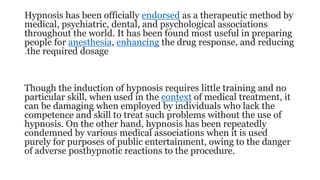سايكو.pptx
- 1. Hyponisis hypnosis, special psychological state with certain physiological attributes, resembling sleep only superficially and marked by a functioning of the individual at a level of awareness other than the ordinary conscious state. This state is characterized by a degree of increased receptiveness and responsiveness in which inner experiential perceptions are given as much significance as is generally given only to external reality.
- 2. • A professor of medicine at Strasbourg. Independently they had written that hypnosis involved no physical forces and no physiological processes but was a combination of psychologically mediated responses to suggestions. (Generally psychoanalysts have come to view hypnosis as merely an adjunct to the free-associative techniques used in psychoanalytic practice.)
- 3. Technique The techniques used to induce hypnosis share common features. The most important consideration is that the person to be hypnotized (the subject) be willing and cooperative and that he or she trust in the hypnotist. Subjects are invited to relax in comfort and to fix their gaze on some object. The hypnotist continues to suggest, usually in a low, quiet voice, that the subject’s relaxation will increase and that his or her eyes will grow tired. Soon the subject’s eyes do show signs of fatigue, and the hypnotist suggests that they will close. The subject allows his eyes to close and then begins to show signs of profound relaxation, such as limpness and deep breathing. He has entered the state of hypnotic trance. A person will be more responsive to hypnosis when he believes that he can be hypnotized, that the hypnotist is competent and trustworthy, and that the undertaking is safe, appropriate, and congruent with the subject’s wishes. Therefore, induction is generally preceded by the establishment of suitable rapport between subject and hypnotist.
- 4. The resulting hypnotic phenomena differ markedly from one subject to another and from one trance to another, depending upon the purposes to be served and the depth of the trance. The central phenomenon of hypnosis is suggestibility, a state of greatly enhanced receptiveness and responsiveness . to suggestions and stimuli presented by the hypnotist
- 5. One fascinating manifestation that can be elicited from a subject who has been in a hypnotic trance is that of posthypnotic suggestion and behaviour; that is, the subject’s execution, at some later time, of instructions and suggestions that were given to him while he was in a trance. With adequate amnesia induced during the trance state, the individual will not be aware of the source of his impulse to perform the instructed act. Posthypnotic suggestion, however, is not a particularly powerful means for controlling behaviour when compared with a person’s conscious willingness to perform actions.
- 6. Hypnosis has been officially endorsed as a therapeutic method by medical, psychiatric, dental, and psychological associations throughout the world. It has been found most useful in preparing people for anesthesia, enhancing the drug response, and reducing the required dosage . Though the induction of hypnosis requires little training and no particular skill, when used in the context of medical treatment, it can be damaging when employed by individuals who lack the competence and skill to treat such problems without the use of hypnosis. On the other hand, hypnosis has been repeatedly condemned by various medical associations when it is used purely for purposes of public entertainment, owing to the danger of adverse posthypnotic reactions to the procedure.
- 7. Done by: Ahmad Darwish 140263 : Student number






